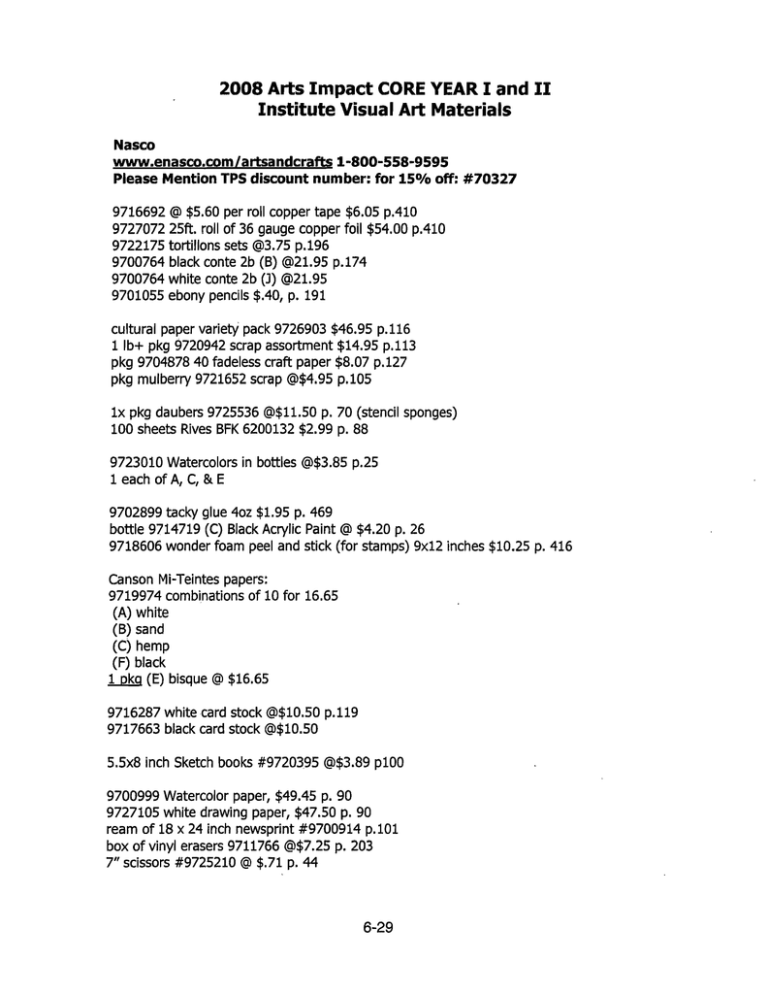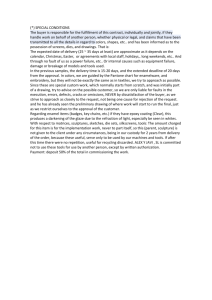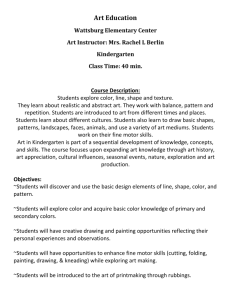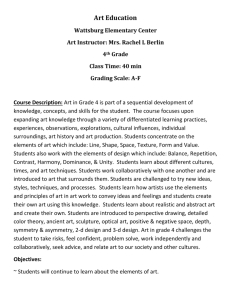2008 Arts Impact CORE YEAR I and II
advertisement

2008 Arts Impact CORE YEAR I and II Institute Visual Art Materials Nasco www.enasco.comlartsandcrafts 1-800-558-9595 Please Mention TPS discount number: for 150/0 off: #70327 9716692 @ $5.60 per roll copper tape $6.05 p.410 9727072 25ft. roll of 36 gauge copper foil $54.00 p.410 9722175 tortillons sets @3.75 p.196 9700764 black conte 2b (B) @21.95 p.174 9700764 white conte 2b (J) @21.95 9701055 ebony pencils $.40, p. 191 cultural paper varietY pack 9726903 $46.95 p.116 1 Ib+ pkg 9720942 scrap assortment $14.95 p.1l3 pkg 9704878 40 fadeless craft paper $8.07 p.127 pkg mulberry 9721652 scrap @$4.95 p.105 lx pkg daubers 9725536 @$11.50 p. 70 (stencil sponges) 100 sheets Rives BFK 6200132 $2.99 p. 88 9723010 Watercolors in bottles @$3.85 p.25 1 each of A, C, & E 9702899 tacky glue 40z $1.95 p. 469 bottle 9714719 (C) Black Acrylic Paint @ $4.20 p. 26 9718606 wonder foam peel and stick (for stamps) 9x12 inches $10.25 p. 416 Canson Mi-Teintes papers: 9719974 combinations of 10 for 16.65 (A) white (B) sand (C) hemp (F) black 1...Q!sg (E) bisque @ $16.65 9716287 white card stock @$1O.50 p.1l9 9717663 black card stock @$10.50 5.5x8 inch Sketch books #9720395 @$3.89 pl00 9700999 Watercolor paper, $49.45 p. 90 9727105 white drawing paper, $47.50 p. 90 ream of 18 x 24 inch newsprint #9700914 p.l0l box of vinyl erasers 9711766 @$7.25 p. 203 7" scissors #9725210 @ $.71 p. 44 6-29 KCDA www.kcda.ora 24702 Drawing pencils, 6B, bonded leads 24722 Drawing pencils, 4B, bonded leads. 24742 Drawing pencils, 2B, bonded leads. 24762 Drawing pencils, HB, bonded leads. 98003 Black China markers. 98006 White China markers. 22767 UHU Glue Sticks .75 oz. @ $.68 22311 Oil pastels, round, 2-3/8"x3/8", 25 asst. colors, 12 boxes/pkg. Nylon Brushes (total approx.$55.00) 6X83701 6X83703 6X"83681 6X 83698 6X 83672 6X 83673 6X83678 6X 83679 Dick Blick www.dickblick.com (800)-828-4548 8x 60500-1010 liner tool @ $.85 8x 60500-1020 modeler tool @ $.85 8x 60500-1030 spatula tool @ $.85 20x 04902-1002 double ended stylis tool @ $1.24 Hardware and Grocery store low tack blue tape: 6 rolls muslin texture and fabric materials chamois (car washing type cut into small pieces) 2 _ x 2 _ in. wooden blocks for stamps 6 x 10 in. _ in. thick plywood for collages paper plates/trays for paint palettes paper towels baby wipes 6-30 Visual Arts Concepts Elements of Art - Arts EALR 1.1.1 Line Line quality/Expressive line - thick, thin, soft, crisp, feathery, bold, dashed, etc. Line direction - straight, curved, vertical, horizontal, diagonal, spiraling, hatching, cross-hatching, etc. Descriptive line - contour, outline Shape Open shape/form - shape/form whose perimeter is broken so that space penetrates it Closed shape/form - shape that completely encloses space, solid form • Organic (irregular shapes, from nature) vs. geometric shapes (regular shapes with math names, made according to rules of geometry, e.g. square, circle, triangle, etc.) Shape (2-D) vs. form (3-D) Value • Black, grey, white - value scales (any number of even gradations between black and white) Tints (adding white) and shades (adding black) to colors Color Three properties of color - hue (name of color), value (lightness or darkness), intensity (brightness or dullness) Color wheel- primary, secondary, tertiary/intermediate colors Warm (yellow, orange, red) vs. cool (blue, green, violet) colors Complementary colors (colors directly opposite each other on the color wheel, e.g. red/green) Neutral colors (colors mixed with their complements) Texture Actual texture - what surface feels like, e.g. rough, smooth, bumpy, ridged Implied texture - 2-D techniques (painting, drawing, printmaking) that suggest the textures of our natural world: hair, velvet, fur, granite, bark, etc. Pattern Repetition of motifs (any shape that repeats) Regular vs. irregular - stripes (bands), zigzags (chevrons), scallop (fish scale), notched (crenellated), checkerboard (counterchange) Mathematical patterns - fractals, tessellations Principles of Organization - Arts EALR 1.1.2 Space Positive space Negative space Compiled by Beverly Harding Buehler 6-31 • Illusion of depth - overlapping, horizon line, perspective (I-point, 2-point, multiple points), diminishing size, atmospheric perspective Composition Open vs. closed composition Emphasis - focal point, dominance vs. subordination Variety • Unity Balance Formal balance (mirror symmetry, radial symmetry) • Informal balance (asymmetry) Skills and Techniques - Arts EALR 1.2 Drawing - gesture, contour, life, still life, landscape, portraiture Painting - ink, watercolor, acrylic, oil Printmaking - stamping, monoprints, relief prints (scratch foam, lino cut, woodcut), silkscreen (serigraph), intaglio (etching with acid) Sculpture - bas-relief (metal tooling, wood cut), in-the-round (free-standing sculpture) Ceramics - hand-building (pinch pots, coil, slab), wheel-throwing Textiles - weaving, quilting, dyeing, paper-making New Media - digital photography, computer graphics Styles - Arts EALR 1.3 Naturalism - observational drawing, rendering in light and shadow, cast shadows, naturalistic proportions Abstraction - simplification, exaggeration, altering space Non-representation - subject has no reference to nature Cultural styles - e.g. Australian Aboriginal dot painting, Northwest Coast Native forrnline design, Islamic tessellated patterns, Celtic eternal knot designs, etc. Historical art movements - e.g. Impressionism, Cubism, Abstract Expressionism, etc. Compiled by Beverly Harding Buehler 6-32 K-5 VISUAL ART GLOSSARY contour - A single line or lines that define the outside edge and often the inner description of objects or figures. ibstract, abstraction - A work of art emphasizing design and simplified or systematic exploration of forms. The subject matter may be recognized or may be completely transformed into shape, color, or line. contour drawing - A single line drawing that defines the outer and inner forms (contours) of either figures or objects., additive sculpture - a sculptural construction technique in multiple medias where materials are added to the sculpture as opposed to taken away. contrast - A difference in value, color, or texture that achieves emphasis or dominance. analysis - A part of the artistic process that considers how art elements are organized and what decision were made by the artist. cool colors - The hues on one side of the color wheel that contain blue and psychologically stimulate a cold, familiar reference or sensation. armature - A framework used to support material being modeled in a sculpture. craftsmanship - Skill and care in use of materials for a resolved, unified work of art. atmospheric perspective - The illusion of space produced by lightening values, softening con.tours and neutralizing colors in objects as they recede. criticism - The formal process of describing and analyzing a work of art leading to interpretation and valuing the art. attribute - A quality, characteristic, or distinctive feature. axis - A straight, center line about which an image or object is symmetrical. crosshatched line - Parallel. crossed lines drawn in more than one direction gradually creating a denser and denser pattern; often used to create a darker value in drawings or printmaking. : background - The part of the image'that depicts what lies behind the SUbject or objects in the foreground. depth - Perception of spatial distance between objects in a two-dimensional work of art. balance - A principle of organization that refers to the visual equalization of elements in a work of art. detail - A small or particular part of a work of art. diagonal - A slanted line obliquely running at an angle to the vertical and horizontal planes. brayers - A small hand roller used to spread ink or paint thinly and evenly over a flat surface. dominance - The principle of compositional organization that suggests one element is more important than others in the ~ame composition. character - Qualities or attributes distinguishing one person or group from another; a person portrayed in an artistic piece (visual, dance, or theater). draft/redraft - To create a preliminary drawing for a proposed work of art and the artistic process of refinement. collage - A technique in which the artist glues materials such as paper, cloth or found materials to some type of ground; actual textures may be found on the picture plane surface. elements of art - Six basic optical units used to communicate or express creative ideas: color. line, shape, space, texture and value. color - The response of vision to the wavelength of light reflected from a surface and identified as red, green, blue, etc. exaggeration - To. increase;or enlarge to an abnormal degree; to distort through overstatement. expression - To communicate strong personal and emotional feelings to the viewer. color wheel - A color theory tool designed to show formal relationships between colors. complementary colors - Any two colors that are located opposite each other on a color wheel which function in high contrast, or mixed to darken the value ofa color. falfade - the front elevation ,of a building. figure - A human shape or form. foreground - The part of the image that appears to be closest to the viewer. ' .:omposltion - The art of organizing all of the elements of a work of art into a harmoniously unified whole. fractional space - Broken or separated into several parts, or only representing a. portion of a view. 4-28 monotype - A printmaking technique where the intent is to make one primary or unique image, though secondary images (ghosts) ,;nay be printed as well. geometric shape - A shape that appears related to geometry, such as the square, triangle, circle, etc. ~esture drawing - A loose, scribble-like, continuous line in loops or free movement that captures the pose of an active figure. movement - A principle of organization in reference to the travel of one's eye through a work of art. narrow palette - A limited range of colors selected for a work of art. gradation - Values or shades that move gradually from one value to the next. negative space - The unoccupied or empty spaces left after the positive shapes have been defined by the artist; negative spaces can function as shapes in the picture plane; sometimes called the background. graphite -A soft steel-gray to black crystallized carbon substance used in drawing pencils. . horizon - The division between earth and sky, as seen by an observer. newsprint paper - A very inexpensive paper usually used for preliminary drawings. horizontal line - A line that is laid down parallel to the top and bottom edge of the paper or surface used to make art. non-representational - Works of art that have no forms reminiscent of actual objects or things. image - An envisioned object or plan given concrete appearance through the use of an art medium; the general appearance of a work. open composition - Forms in painting and drawing that are made incomplete at: the edge of the composition with an emphasis on and the illusion that these objects proceed beyond the picture plane edge. imprint - To make or impress upon a surface. interpretation - A part of art criticism where the viewer reaches an understanding about the meaning of art, supported by objective criteria. 'din (kill) - An oven capable of controlled high temperatures in which clay objects are fired or baked. organic shapes - Free forms or shapes that represent living things with irregular edges. painting - An image composed of applied colors; the art of producing such works. palette - A group of colors u'sed by an artist or school of art; a flat surface on which a painter places the supply of paint to be used. *Kraft™ paper - A brand of intensely-colored allpurpose, paper appropriate as a replacement for construction paper - accepts silk-screening, waterbased paints, collage, and oil pastel; *Fadeless® paper adds qualities of fade resistance and the ability to not crack to Kraft™ paper. pattern - The obvious emphasis on visual form relationships and certain directional movements within the picture plane. Pattern also refers to the repetition of art elements or the combination of elements in a readily recognizable systematic organization. picture plane - The imaginary flat surface or plane in which the artist references and organizes images. landscape - A work of art that shows the features of the natural environment. point of view - The position from which something is considered. line - The path of a moving point, a mark made by a tool or instrument across a surface. It may be twodimensional, three-dimensional, or implied. portrait - The image of a person's face. *Lyra® pencils - A brand of colored pencils with extrasoft, long-lasting pigments. positive space - Objects in 'a work of art as opposed to the background or space ~round the objects. mark making - The stylistic notations made by individual artists when they draw. primary colors - the hues from which all other spectrum colors can be made: red, yellow, and blue (painting). medium, media - The materials and tools used by the artist to create the visual elements perceived by the viewer of the art. print - a mUltiple impression made from a master plate or block, produced and printed by the artist (or under his/her supervision). middle ground - A representation of space or point of view mid-way between the extremes.offront and back. 4-29 proportion - The comparison of elements one to another in terms of their properties of size, quantity, and degree of emphasis. still life - A group of inanimate objects arranged to be painted or drawn. ,'atio - The relationship in number or degree between two things. strokes - A mark made by marking instrument, either a paintbrush or drawing tool. relief print - Printmaking techniques in which the image is printed from the raised areas of the printmaking block, usually created by cutting away areas of the block. Wood and linoleum as well as collagraph prints are considered relief prints. sulfite paper - A heavy white drawing paper with special sizing to accept a variety of drawing media. a symbol - A form, mage, icon, or subject that represents an idea or meaning other than its outward appearance. repetition - The use of the same visual element a number of times in the same composition. Repetition can accomplish a dominance of one visual idea, a feeling of harmonious relationship, an obviously planned pattern, or a rhythmic movement. symmetry, symmetrical- A formally balanced composition. technique - The manner and skill with which artists employ their tools and materials. representational - Any artistic style in which objects or figures are easily identified. rhythm - A principle of organization that indicates a type of movement in art or design, reinforced by repeated shapes, lines, or colors. tempera paint - An opaque water-based paint. . template - A pattern used as a guide to transfer or draw an image accurately. score - To scratch both surfaces of clay that will be adhered together. textile - Fabric, fiber, or yarn in a woven format. texture - the element of art that refers to the quality of a surface, both tactile and visual. sculpture - A three-dimensional work of art. secondary colors - Orange, green and violet; hues )reduced by the mixing of equal parts of two primary colors. two-dimensional - Having height and width. setting - The context or environment in which something occurs: time, place, scenery, images. unity - A principle of organization that relates to the sense of oneness or wholeness in a work of art. shape - An element of art representing enclosed space, having only two dimensions. value - An element of art that relates to the lightness or darkness of a color or tone. vertical Jines - Lines that are upright and parallel to the sides of the paper or drawing surface. three-dimensional- Having height, width, and depth. simplification - To make less complex; without embellishment or unnecessary detail. viewpoint - The position from which something is considered. slab - A formation of clay into a sheet of uniform thickness, made prior to construction or manipulation. warm colors - The hues on: one side of the color wheel that contain red and psychologically slip - Clay in a water state; usually similar to the thickness of sour cream. watercolor paint - A paint that uses water as a . medium. space - An element of art that indicates areas in work of art (positive and negative; also, the feeling of depth in a work of art. *The brand names used in the Hockinson School District Visual Art Glossary are not product 'endorsements, but explanations of the qualities of art materials frequently used in the classroom. The Hockinson School District endorses the use of art materials certified for use in the classroom and with children (AP and CP). The Glossary for the Hockinson School District Visual Art Glossary was written in reference to the following sources. These resources could be used in tandem to supplement the above list 'of art vocabulary terms: Robert O. Bone, Otto G. Ocvirk, Robert E. Stinson, Phillip R. Wigg, Fundamentals: Theory and Practice. Dubuque, Iowa, Wm. C. Brown Publishers, 1990. . 4-30 Gerald F. Brommer, Discovering Art History. Worcester Massachusetts: Davis PUblications, 1997. Gerald F. Brommer, Exploring Drawing. Worcester, Massachusetts: Davis Publications, Inc., 1988. Jack Ho~bs & Richard Salome. The Visual Experience. Worcester, Massachusetts: Davis PUblications,. Inc., 1995. Lake Washington School District Visual Art Curriculum; Ocean Beach School District Visual Art Curricuium; facoma School District Visual Art Curriculum Webster's" New Riverside University Dictionary. Boston, Massachusetts: Houghton Mifflin Company,: 1995. 4-31




